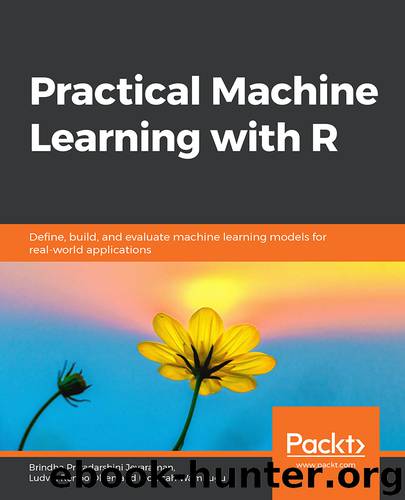Practical Machine Learning with R by Brindha Priyadarshini Jeyaraman Ludvig Renbo Olsen and Monicah Wambugu

Author:Brindha Priyadarshini Jeyaraman, Ludvig Renbo Olsen,
and Monicah Wambugu
Language: eng
Format: epub
Publisher: Packt Publishing Prvt Ltd
Published: 2019-08-30T00:00:00+00:00
Figure 5.1: Datasets
Linear Regression
When performing linear regression, we are trying to find linear relationships between variables. Suppose we have a cat shelter and want to know how many extra cans of cat food we need to buy after receiving new cats. A simple approach would be to find the average number of cans a cat eats per day (z) and multiply it by the number of new cats (x). This is a linear relationship: if the number of cats increases by x, make sure to buy x times z cans of cat food. Of course, other variables might affect how much a new cat eats, such as age, breed, and weight at birth. We could possibly make a better linear model by adding these as predictors.
Imagine we had measured the amount of food eaten by 85 cats, along with their weight at birth (in grams). For budgeting reasons, we wish to predict the amount of food (number of cans) a newborn cat will eat per day when it grows up. We can plot these variables against each other, as shown in Figure 5.2:
Download
This site does not store any files on its server. We only index and link to content provided by other sites. Please contact the content providers to delete copyright contents if any and email us, we'll remove relevant links or contents immediately.
| Computer Vision & Pattern Recognition | Expert Systems |
| Intelligence & Semantics | Machine Theory |
| Natural Language Processing | Neural Networks |
Algorithms of the Intelligent Web by Haralambos Marmanis;Dmitry Babenko(7891)
Hadoop in Practice by Alex Holmes(5682)
Jquery UI in Action : Master the concepts Of Jquery UI: A Step By Step Approach by ANMOL GOYAL(5535)
Life 3.0: Being Human in the Age of Artificial Intelligence by Tegmark Max(4551)
Functional Programming in JavaScript by Mantyla Dan(3740)
The Age of Surveillance Capitalism by Shoshana Zuboff(3463)
Big Data Analysis with Python by Ivan Marin(3237)
Blockchain Basics by Daniel Drescher(2923)
Test-Driven Development with Java by Alan Mellor(2835)
The Rosie Effect by Graeme Simsion(2742)
WordPress Plugin Development Cookbook by Yannick Lefebvre(2676)
Data Augmentation with Python by Duc Haba(2676)
Hands-On Machine Learning for Algorithmic Trading by Stefan Jansen(2590)
Applied Predictive Modeling by Max Kuhn & Kjell Johnson(2514)
Principles of Data Fabric by Sonia Mezzetta(2492)
Dawn of the New Everything by Jaron Lanier(2457)
The Infinite Retina by Robert Scoble Irena Cronin(2420)
The Art Of Deception by Kevin Mitnick(2324)
Microservices with Spring Boot 3 and Spring Cloud by Magnus Larsson(2269)
